SAPPHIRE Radeon HD 6970 Review Index
- 1 – Meet with SAPPHIRE’s Radeon HD 6970
- 2 – SAPPHIRE Radeon HD 6970 Features
- 3 – SAPPHIRE Radeon HD 6970 OpenGL performances
- 4 – SAPPHIRE Radeon HD 6970 Direct3D performances
- 5 – SAPPHIRE Radeon HD 6970 Gaming performances
- 6 – SAPPHIRE Radeon HD 6970 DirectCompute performances
- 7 – SAPPHIRE Radeon HD 6970 Power consumption and overclocking
- 8 – SAPPHIRE Radeon HD 6970: Conclusion and Misc Links
4 – SAPPHIRE Radeon HD 6970 Direct3D performances
4.1 Unigine Heaven (DirectX 11)
OpenGL tests have been finished on Unigine Heaven, what a better transition than starting Direct3D tests with Unigine Heaven 2.1, this time using the Direct3D 11 render path.
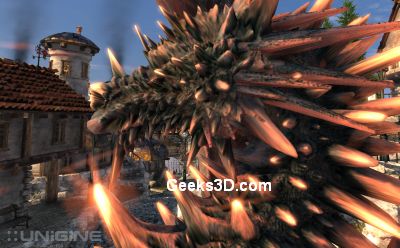
Settings: 1920×1080 fullscreen, tessellation: normal, shaders: high, 4X MSAA, 16X anisotropic filtering.
| 47.9 FPS, Scores: 1208 – EVGA GTX 580 SC |
| 47.6 FPS, Scores: 1200 – ASUS ENGTX580 |
| 42.9 FPS, Scores: 1081 – SAPPHIRE Radeon HD 6970 |
| 39.4 FPS, Scores: 991 – EVGA GeForce GTX 480 |
| 26.8 FPS, Scores: 674 – ATI Radeon HD 5870 |
| 25.9 FPS, Scores: 653 – ASUS EAH6870 |
| 25.3 FPS, Scores: 637 – SAPPHIRE Radeon HD 6870 |
| 25.6 FPS, Scores: 646 – MSI N460GTX Cyclone 768D5 |
| 16.6 FPS, Scores: 419 – MSI R5770 Hawk |
4.2 3DMark11 (Direct3D 11)
3DMark11, Furturemark’s new Direct3D benchmark (see here for more details: 3DMARK11: New Gamer’s Benchmark for DirectX 11 is There (+ Big Pictures)),
has been added in Geeks3D’s benchmarks suite for graphics cards reviews.
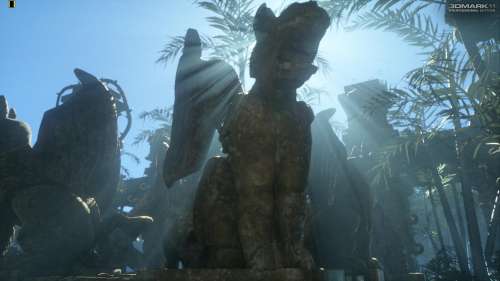
3DMARK11 Entry mode (1024×600)
| E8463 – EVGA GeForce GTX 580 SC |
| E7598 – EVGA GeForce GTX 480 |
| E7481 – SAPPHIRE Radeon HD 6970 |
| E7137 – MSI R5770 Hawk 2-way CrossFire |
| E6285 – ATI Radeon HD 5870 |
| E6206 – SAPPHIRE Radeon HD 6870 |
| E5270 – MSI N460GTX Cyclone 768D5 OC |
| E4166 – ATI Radeon HD 5770 |
3DMARK11 Performance mode (1280×720)
| P5947 – EVGA GeForce GTX 580 SC |
| P5174 – EVGA GeForce GTX 480 |
| E5119 – SAPPHIRE Radeon HD 6970 |
| P4887 – MSI R5770 Hawk 2-way CrossFire |
| P4284 – ATI Radeon HD 5870 |
| P4188 – SAPPHIRE Radeon HD 6870 |
| P3251 – MSI N460GTX Cyclone 768D5 OC |
| P2648 – ATI Radeon HD 5770 |
3DMARK11 Extreme mode (1920×1080)
| X2020 – EVGA GeForce GTX 580 SC |
| X1812 – SAPPHIRE Radeon HD 6970 |
| X1672 – EVGA GeForce GTX 480 |
| X1565 – MSI R5770 Hawk 2-way CrossFire |
| X1565 – ATI Radeon HD 5870 |
| X1399 – SAPPHIRE Radeon HD 6870 |
| X947 – MSI N460GTX Cyclone 768D5 OC |
| X875 – ATI Radeon HD 5770 |
4.3 MSI Kombustor (Direct3D 9)
MSI Kombustor 1.1.3 has been used for the test. MSI Kombsutor is a Direct3D 9, 10, 11 and OpenGL 2 and 3 stress test and benchmark. I only tested the Direct3D 9 rendering.
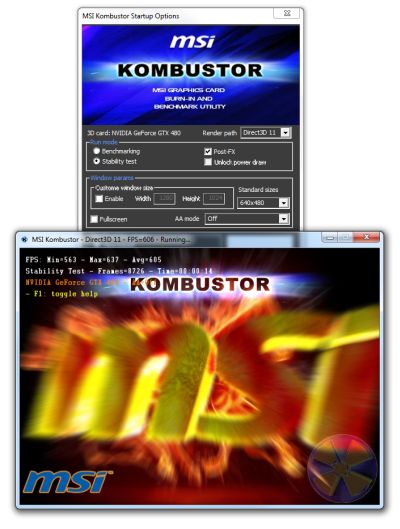
Settings: 1920×1080 fullscreen, no AA, no postFX, 60sec, Unlock power draw CHECKED (the real benchmark mode!).
| 2450 (41FPS) – Sapphire Radeon HD 6970 |
| 2425 (40 FPS) – EVGA GeForce GTX 580 SC, ***OCP disabled*** |
| 2378 (40FPS) – ASUS ENGTX580 ***OCP disabled*** |
| 1991 – EVGA GeForce GTX 480 |
| 1962 – ATI Radeon HD 5870 |
| 1833 – ASUS EAH6870 |
| 1816 – Sapphire Radeon HD 6870 |
| 1738 – ASUS ENGTX580 |
| 1595 – MSI GeForce GTX 470 |
| 1490 (25 FPS) – EVGA GeForce GTX 580 SC, OCP enabled |
| 1201 – MSI N460GTX Cyclone 768D5 OC |
| 943 – MSI R5770 Hawk (Cat 10.7) |
4.4 NVIDIA Island Demo: Tessellation (Direct3D 11)
NVIDIA Island demo is a D3D11 demo focused on, what a surprise, tessellation!
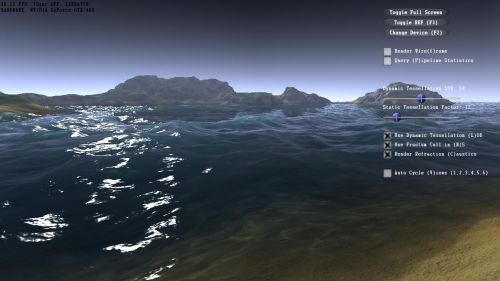
Settings: windowed (default size) and default params (tess factor: 12).
| FPS: 58 – EVGA GTX 580 SC |
| FPS: 57 – ASUS ENGTX580 |
| FPS: 46 – EVGA GTX 480 |
| FPS: 25 – MSI N460GTX Cyclone 768D5 OC |
| FPS: 15 – Sapphire Radeon HD 6970 |
| FPS: 13 – ASUS EAH6870 |
| FPS: 13 – Sapphire Radeon HD 6870 |
| FPS: 11 – ATI Radeon HD 5870 |
| FPS: 10 – MSI R5770 Hawk |
4.5 DirectX SDK SubD11: Tessellation (Direct3D 11)
SubD11 is a Direct3D tessellation demo from the DirectX 11 SDK June 2010.
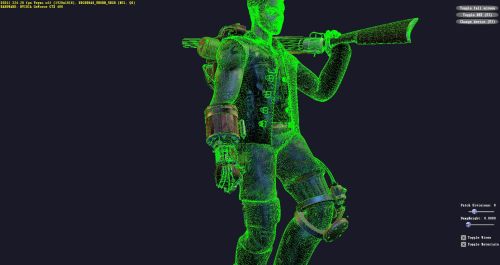
Settings: 1920×1080 windowed, tessellation: 8X
| FPS: 256 – EVGA GTX 580 SC |
| FPS: 250 – ASUS ENGTX580 |
| FPS: 220 – EVGA GTX 480 |
| FPS: 135 – MSI N460GTX Cyclone 768D5 OC |
| FPS: 106 – Sapphire Radeon HD 6970 |
| FPS: 74 – ASUS EAH6870 |
| FPS: 73 – Sapphire Radeon HD 6870 |
| FPS: 60 – ATI Radeon HD 5870 |
| FPS: 53 – MSI R5770 Hawk |
Remark: compared to TessMark, this test shows the increase of Cayman tessellation performance compared to Cypress and Barts GPU. The Direct3D driver has been updated to take advantage
of the new architecture while it’s not the case for the OpenGL driver 🙁 !
Settings: 1920×1080 windowed, tessellation: 16X
| FPS: 120 – EVGA GTX 580 SC |
| FPS: 118 – ASUS ENGTX580 |
| FPS: 102 – EVGA GTX 480 |
| FPS: 59 – MSI N460GTX Cyclone 768D5 OC |
| FPS: 29 – Sapphire Radeon HD 6970 |
| FPS: 19 – ASUS EAH6870 |
| FPS: 18 – Sapphire Radeon HD 6870 |
| FPS: 16 – ATI Radeon HD 5870 |
| FPS: 15 – MSI R5770 Hawk |
Settings: 1920×1080 windowed, tessellation: 24X
| FPS: 52 – EVGA GTX 580 SC |
| FPS: 51 – ASUS ENGTX580 |
| FPS: 44 – EVGA GTX 480 |
| FPS: 27 – MSI N460GTX Cyclone 768D5 OC |
| FPS: 11 – Sapphire Radeon HD 6970 |
| FPS: 8 – ASUS EAH6870 |
| FPS: 8 – Sapphire Radeon HD 6870 |
| FPS: 8 – ATI Radeon HD 5870 |
| FPS: 7 – MSI R5770 Hawk |
Settings: 1920×1080 windowed, tessellation: 31X
| FPS: 30 – EVGA GTX 580 SC |
| FPS: 30 – ASUS ENGTX580 |
| FPS: 26 – EVGA GTX 480 |
| FPS: 16 – MSI N460GTX Cyclone 768D5 OC |
| FPS: 7 – Sapphire Radeon HD 6970 |
| FPS: 5 – ASUS EAH6870 |
| FPS: 5 – Sapphire Radeon HD 6870 |
| FPS: 4 – ATI Radeon HD 5870 |
| FPS: 4 – MSI R5770 Hawk |
SAPPHIRE Radeon HD 6970 Review Index
- 1 – Meet with SAPPHIRE’s Radeon HD 6970
- 2 – SAPPHIRE Radeon HD 6970 Features
- 3 – SAPPHIRE Radeon HD 6970 OpenGL performances
- 4 – SAPPHIRE Radeon HD 6970 Direct3D performances
- 5 – SAPPHIRE Radeon HD 6970 Gaming performances
- 6 – SAPPHIRE Radeon HD 6970 DirectCompute performances
- 7 – SAPPHIRE Radeon HD 6970 Power consumption and overclocking
- 8 – SAPPHIRE Radeon HD 6970: Conclusion and Misc Links
According to PCGH Cat10.12a hotfix boosts D3D tessellation, OpenGL tessellation tweaking is scheduled for Q1/2011
http://www.pcgameshardware.de/aid,804732/Neuer-HD-6900-Treiber-steigert-Tessellationsleistung-um-bis-zu-75-Prozent/Grafikkarte/News/
Great news for the upcoming OpenGL tessellation optimizations. Thanks Stefan!
Pingback: [Tested] Radeon HD 6970 PowerTune Technology - 3D Tech News, Pixel Hacking, Data Visualization and 3D Programming - Geeks3D.com
I noticed that Cayman has one more OpenCL extension than Barts or Cedar – cl_amd_fp64 i assume?
I don’t know. I’ll tell you when I re-plug the HD 6970 on my testbed.
Pingback: [Tested] AMD Catalyst 11.1a: OpenGL Tessellation Support is Slightly… Broken - 3D Tech News, Pixel Hacking, Data Visualization and 3D Programming - Geeks3D.com
Pingback: The True Reason Behind AMD HD 6970/6950 Delay: Each Card is Hand-crafted! - 3D Tech News, Pixel Hacking, Data Visualization and 3D Programming - Geeks3D.com
Pingback: [Tested] Catalyst 11.1a Hotfix (Jan26): Gains up to 18% in OpenGL Tessellation (TessMark) - 3D Tech News, Pixel Hacking, Data Visualization and 3D Programming - Geeks3D.com
Will my PSU be able to power this card?
I have a S-ATA Netzteil ATX Power supply MS N55-VAL
I it good enough to power this card?